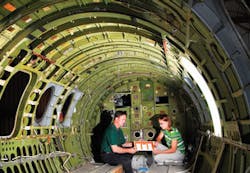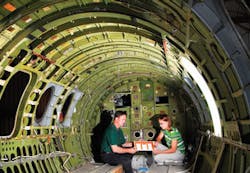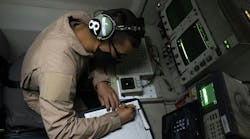By Courtney E. Howard
ALBUQUERQUE, N.M. - Scientists at Sandia National Laboratories in Albuquerque are developing sensors to monitor the condition of aircraft structures and systems.
A team of scientists at Sandia, led by Dennis Roach, envision networks of sensors mounted on aircraft continuously checking for the formation of defects.
Structural health monitoring (SHM) sensors can find fatigue damage, hidden cracks in hard-to-reach locations, disbonded joints, erosion, impact damage, and corrosion, among other defects commonly encountered in aging aircraft. Ultimately an integrated network of sensors could monitor not only structural elements, but also the health of electronics, hydraulics, avionics, and other systems, explains a Sandia representative.
The Sandia team has not only evaluated, but also developed several sensors that can be mounted on aircraft to ensure structural integrity. A comparative vacuum monitoring (CVM) sensor-a thin, self-adhesive, rubber patch that varies in size from the equivalent of a dime to that of a credit card-detects cracks in underlying material. Laser-etched with rows of interconnected channels, the CVM sensor from Structural Monitoring Systems (SMS) in Osborne Park, Australia, detects changes in pressure resulting from the formation of one or more cracks.
SHM techniques are gaining the support of airframe manufacturers, airlines, and regulators, Roach explains. In fact, The Boeing Company in Chicago is credited as the first manufacturer to adopt SHM techniques. Boeing engineers incorporated an in situ, or permanently-mounted, crack-detection sensor into its nondestructive inspection (NDI) standard practices manual for Boeing airframes.
This move is indicative of an industry ready to consider new ways of ensuring the safety of aircraft beyond human inspection, Roach explains. The inclusion of CVM technology in Boeing’s Common Methods NDI Manual stems from Sandia’s two-year validation program in cooperation with the FAA, Boeing, SMS, U.S. airlines, and the University of Arizona.
Boeing’s milestone has spurred other commercial airlines to investigate SHM applications. Several firms are working with Boeing and the Federal Aviation Administration toward the adoption of embedded crack-detection sensors.
“There is recognition that SHM’s time has come, an opinion you would not have heard a few years ago,” Roach says.
SHM techniques can be applied to monitor the structural well-being of spacecraft, weapons, rail cars, bridges, oil recovery equipment, buildings, and fuel tanks in hydrogen vehicles, Roach explains. Sandia personnel are working on the application of SHM sensor systems-including flexible eddy-current arrays, capacitive micro-machined ultrasonic transducers, piezoelectric transducers, acoustic emission sensors, embedded fiber optics, and nickel strip magnetostrictive sensors-to various structures.
Sandia is part of the Aerospace Industry Steering Committee for Structural Health Monitoring, a group of manufacturers, regulators, government agencies, the military, and universities. The work also is related to Sandia’s Airworthiness Assurance Program, focused on the development and evaluation of NDI technologies to aid human inspectors looking for evidence and consequences of aging.
For more information, visit Sandia National Laboratories online at www.sandia.gov.




